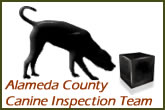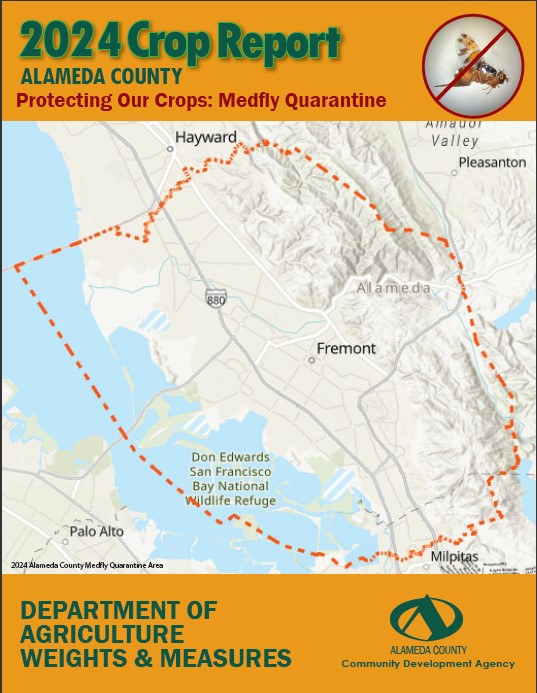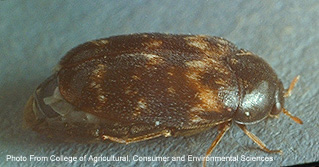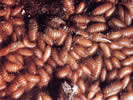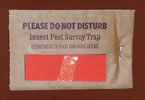Pest Detection
Khapra Beetle
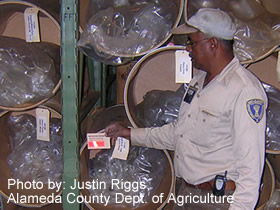
Inspecting Khapra beetle
traps in a spice warehouse.
Common Name: Khapra Beetle
Scientific Name:Trogoderma granarium
Pest Rating: "A"
DESCRIPTION
The adult is a small oval pubescent, yellowish to reddish brown beetle, about 1.8mm - 3.8 mm long. Females are often twice the size of males and often lighter in color. Hairs on the dorsal surface are easily rubbed off giving the beetle a shiny appearance. Young larvae are yellowish brown but become reddish brown as they mature, and are covered with long hairs. The posterior abdominal segments have long, erectile hairs resembling a tail. Larvae range in length from about 1.6 mm for first instars to 6mm for final instars.
HISTORY AND ECONOMIC IMPORTANCE
Khapra beetle is considered to be one of the world's most destructive pests of stored food products. It is a voracious feeder of grain products, can tolerate colder climates and is capable of hiding in cracks and staying in a diapausal state for up to six years.
In the United States, Khapra beetle has been found infesting unprocessed stored materials such as; wheat, oat, barley, flaxseed, pinto beans, black eyed peas, sorghum, alfalfa seed, cotton seed and castor bean. Some preferred processed hosts include; corn meal, flour, bread, cotton seed meal, cotton seed cake, oats, breakfast cereals, crackers, dog food, powdered milk, raisins, and nutmeats.
Recent infestations of Khapra beetle in the U.S. have been associated with spices, burlap bagging on either food or non-food products that were infested, paper boxes and packing material used with steel products, art objects, and other items imported from Khapra beetle infested areas.
The Trogotrap is made from 3" x 4" piece of corrugated cardboard, with an attractant food paste spread inside the corrugations. The food paste is made from powdered milk, ground-up insect bodies, and wheat germ. Insects of stored food products enter the corrugated cardboard for food, shelter, and reproduction.
DISTRIBUTION
Khapra beetle is apparently native to India. It has been reported that it was distributed in Southeast Asia, the Middle East, North Africa, Europe, China, Japan, Korea, Philippines, Australia and Madagascar, and has become established in most of those countries.
ALAMEDA COUNTY PEST DETECTION
Insect detection traps are placed and monitored in high hazard facilities receiving products from foreign countries. High hazard facilities include large food mills, wholesale bakeries, wholesale spice centers, seed companies, burlap bag cleaning establishments, carpet mills, import stores, coffee grinders, etc.
Agriculture inspectors monitor over 300 trogotraps distributed throughout Alameda County in 26 facilities. Some of these facilities include chocolate factories, spice warehouses, coffee grinders, feed and grain stores, port of entry storage facilities, and international markets.
HOSTS AND DAMAMGE
Khapra beetle will feed on most any dried plant or animal matter but prefers grain and cereal products. Particularly wheat, barley, oats, rye, maize, rice, flour, malt and noodles. Other host includes garbanzo, soybean, lentil, ground corn, ground dog food, and a variety dried fruits and nutmeat.
YOU CAN HELP
Working together we can keep these pests from becoming established in Alameda County. You can help by allowing Agriculture employees access to your property to install and monitor insect survey traps. To learn more, select the link below:
Pest Detection Survey

 Community Development Agency
Community Development Agency AGRICULTURE PROGRAMS
AGRICULTURE PROGRAMS